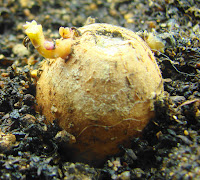This being said, the sweet potato has become a big part of our culinary endeavors. Steak and baked potato has become steak and baked sweet potato. Roasted pork loin with mashed potatoes has, yes you guessed it...mashed sweet potatoes. There is so many ways to introduce sweet potatoes into your meals.
Marin makes this vegetarian dish with sweet potatoes, chickpeas, raisins, and some other things I can't remember. But, it's poured over cous cous. It's awesome. Maybe she can put it on here sometime. Don't get me wrong. I love the good ole' common potato just as much as the next person. In fact, we grow those as well. But, having sweet potatoes in the garden offers us variety. Let's us shake things up a bit.
Now, let's talk about growing them. First, you could go out and buy "slips" to plant in your garden. But, for all of you who like a more hands on approach, try this. Pick yourself up a sweet potato and toothpicks from the store or your pantry if applicable. Cut the potato in half. Fill a wide mouthed jar with warm water. Take 3 toothpicks and stick them into the sweet potato. These will hold the sweet potato in place as you submerge the sweet potato into the glass of water. Only half of the potato should be submerge. Many may have done this very same process back in grade school science class. All that's left is to keep your potato warm over the next couple of weeks. You will begin to see roots forming on the lower half and the "slips" emerging on the top half. This is, however, possible to do by placing the cut side down into a pot of soil. As you can see in the pictures below, I have 4 potatoes at different stages of growth. This is the first year trying it in soil, but the above method has always worked. 1 sweet potato is capable of growing up to 50 slips. Each slip is capable of producing several pounds of sweet potatoes.
Now that your slips are growing leaves, place them in a sunny window. Sweet potatoes are warm season crops. Here in Austin, we are zone 8b. Suggested time of planting slips is around the middle of April. Once your slips are around 6 inches or so, you can twist them off the "mother". Fill a shallow dish with warm water and lay the root end in the water with the leaves hanging out. Within a few days your slips will be rooted and they can be placed in your garden beds. Keep in mind, the sweet potato plant is a vine. Give it plenty of depth to produce the "tubers" as they grow underneath the soil. Although they can grow in all different types of soil, the less compacted the better. Now as for the vine, it will creep, climb, cover, stretch, and branch out all over the place. If the vine is allowed to crawl on the ground it will root itself along the way. The more rooting, the more potatoes. These can also be used as an ornamental in the landscape as a temporary privacy screen if trained up a trellis. Keep your vines evenly watered, especially while they are producing their tubers. We usually harvest around the end of July. When harvesting, be very gentle. Place your shovel or garden fork in the soil and lift the soil up to loosen it. Once loosened, we generally use our hands to dig out the sweet potatoes. You will have some small potatoes mixed in as this is normal. After basking in the glory of your harvest, it's time to cure them. Do not be tempted to wash or eat your sweet potatoes right away. They are still fairly tender and any nick, scrape, or cut can cause them to rot. Instead, leave the soil on and place them in a dry area for about a week or 10 days. This stage is crucial for best tasting sweet potatoes, otherwise they will be starchy, even gluey. Unless you were that kid in art class who liked eating the paste. (Okay, okay. I liked it then but I don't anymore. Just Kidding) This curing period allows the starches to turn to sugar, thus making a more sweeter potato. After this period, they can be scrubbed cleaned and eaten. Store them in a dark and dry environment. That's all there is to it. Low maintenance, large producer, and good to eat... My kinda veggie!




This comment has been removed by the author.
ReplyDeleteThis idea sounds simple enough that I could maybe do that! Not too early for me to start that up here in PA, is it?
ReplyDeleteBTW, yes Marin, please post your recipe!!!
Yes. Do it this weekend. I think it would be fun for the girls to watch. It's so easy
ReplyDeleteSweet potato is a highly nutritious and an alternative for food for their valuable contents of carbohydrate, protein and carotene, which are necessary for normal development and even for the sexual development too, believe it or not. Sweet potato is really helpful for welfare and our body.
ReplyDeletebuy viagra